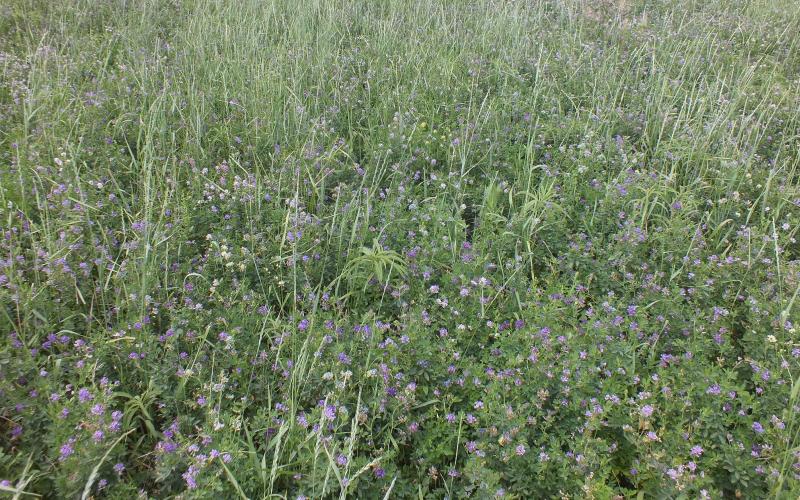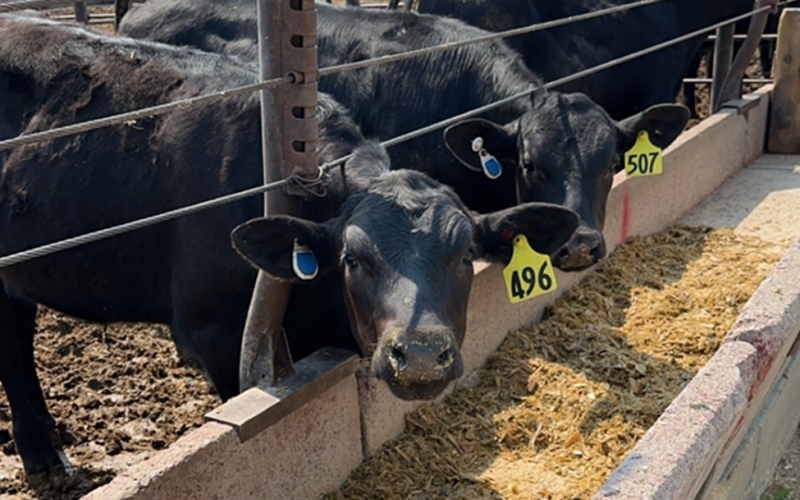Written by Patricia Villamediana, former SDSU Extension Dairy Field Specialist.
The use of embryo technologies has been described as an alternative to improve pregnancy and accelerate genetic improvement in dairy cows. Embryo transfer is the process by which an embryo is collected from the donor and transferred to another recipient to complete the gestation period. The transfer of an embryo to a synchronized recipient has the potential to improve fertility, because it bypasses fertilization and early embryo development, which are critical stages for a successful pregnancy. Bovine embryo transfer technology involves the selection and management of donor and recipient animals, the collection, short-term storage or freezing and transfer of embryos. Embryos also can be produced in the laboratory via techniques such as in vitro fertilization (IVF).
Recent Production Trends

The last annual report of the International Embryo Technology Society and the American Embryo Transfer Association reporting embryo transfer (ET) activities featured that U.S. bovine embryo production increased in 2020. Different trends were observed for in vivo derived (IVD) and in vitro produced (IVP) embryos, with an 11.7% decrease in the IVD embryos collected in 2020 compared to 2019 (148,012 vs. 167,705; respectively). Furthermore, the IVD embryos collected have decreased steadily since 2015, whereas IVP embryo production increased (+11.7%; 526,791 vs. 471,456 in 2020 and 2019, respectively).
The number of bovine embryos (IVD and IVP) actually transferred in 2020, remained nearly stable compared with 2019 (433,959 vs. 448,826, respectively). The IVD transferred embryos showed a 7.5% reduction in 2020 compared to 2019 (132,811 vs. 143,585; respectively); however, the IVP transferred embryos remained mostly stable in 2020 compared to 2019 (+1.3%; 301,148 vs. 305,241). In 2020, 69% of the bovine embryo actually transferred was produced in vitro.
The United States is the second worldwide country with 22.9% (41,928 embryos) of the dairy bovine in vivo derived embryos after Europe (58.1%; 106,456 embryos). Superovulation efficiency in the United States has an estimated average of 10.5 ova and 6.3 transferable embryos per flush. In 2020, 35.7% (8415) of the total flushes (23,934) were done in dairy cattle breeds, where fewer embryos were collected per flush (4.8 vs. 6.3 average viable embryos per total flush). It is known that this reduction is probably due to the increased proportion of sexed semen used in dairy females (45 vs. 22% in total females). The sperm sorting process takes much longer than conventionally processed semen.
In the United States, there are more IVD frozen-thawed (64.1%) than fresh embryos transferred. Cryopreserved embryos were not predominant in dairy breeds (11.1% of the total IVD embryos transferred). In 2020, 54.1% of dairy IVD embryos (17,3101) were transferred fresh. These differences may be explained by the dairy farm reproductive management programs.
In the United States, IVP totals increased by 11.7% in 2020 compared with 2019 (526,791 vs. 471,456, respectively), and most of the IVP embryos were from dairy breeds (57.5%; 302,980 out of 526,791). The in vitro production of transferrable embryos generated using dairy cow abattoir-derived oocytes showed a notorious 73.8% reduction in 2020 compared to 2019 (790 vs. 2,981 embryos; respectively).
The proportion of frozen-thawed IVP embryos transferred in the United States decreased from 43.4% in 2019 (132,530) to 41.0% in 2020 (123,528). This 2.4% reduction may be explained by the increase of the fresh embryos rather than a decrease in frozen-thawed embryos transferred. In 2020, 71% of the total IVP dairy embryos (196,831) were transferred fresh.
The United States exported 23.4% more bovine embryos in 2020 compared with 2019 (29,262 vs. 23,719, respectively), with increases in both IVD (+18.7%) and IVP (+35.9%) embryos. Exported bovine embryos were predominantly from dairy breeds (83.8%), been Holsteins 91.3% (19,938) of them. Regarding exported dairy cattle IVP embryos, 21.4% or 4,663 were produced in vitro, with oocytes recovered by Ovum Pick Up (OPU). In 2020, the United States imported 131 dairy embryos from the 498 total bovine embryos imported, being the majority from Canada.
In vitro embryo transfer has become the technique of choice for embryo production. As the efficiency of embryo production by OPU-IVF is higher than that by in vivo embryo production, it is likely the best strategy to respond effectively to the demand for genetically superior breeding animals. In 2020, the increased IVP embryos had a similar growth rate to fresh IVP embryos transferred (+2%), but not frozen-thawed IVP embryos (-2%). The transfers of frozen-thawed IVP embryos have been growing over the past decade; however, from 2019 to 2020, the percentage of IVP cryopreserved embryos showed a slight decrease (43% vs. 41%; respectively) which may be circumstantial.
In vitro embryo production in the United States is successful and accounts for 46.5% of all cattle IVP embryos recorded worldwide (1.132,773). Cattle embryo production (IVD+IVP) increased worldwide in 2020 and has been the highest in five years. Despite the progressive reduction in IVD embryos collected, the increase in IVP embryos resulted in a record of 1.5 million embryos in 2020. The 2020 records showed that the overall embryo activity increased compared to 2019 (+7%). The COVID-19 Pandemic impacted all agriculture sectors, but other factors, such as the demand for replacement animals and embryo technologies, could be responsible for the increased embryo transfer activity.
“Many important assisted reproductive technologies companies have settled in South Dakota to provide dairy producers with fast animal genetic improvement and, consequently, a more-efficient, profitable and sustainable operation.”
Use in South Dakota
In the last years, producers in South Dakota have been applying these assisted-reproductive techniques, as the state has increased its milk production by 27% since 2019 and 60% in the last ten years. Many important assisted reproductive technologies companies have settled in South Dakota to provide dairy producers with fast animal genetic improvement and, consequently, a more-efficient, profitable, and sustainable operation.
In 2020, South Dakota performed 49,657 ET (11.44% of the total U.S. 433959 ET), where 33,833 ET were carried out in dairy breeds (14.8%; 228,854 total U.S. dairy transferred). The ET growth rate in South Dakota represents an increase of 161.5% in general in 2020 compared with 2019 and the dairy ET in particular escalated to 473% increase. South Dakota is now the most-improved state in the nation, ranking first in ET followed by Texas and Oregon.
The lower embryo cryotolerance and reduced pregnancy rates found in IVP technology are still concerns for its implementation worldwide; however, in vitro cattle embryo production has shown significant progress in recent years. The combination of in vitro production with sexed semen and genomic selection is being successfully used in North America, as shown in the data presented. Assisted reproductive techniques have been successful in the commercial field to help producers improve reproductive performance, efficiency and genetic gain.
Contact us if you need assistance finding out about the IVP technology that would best fit your operation!
References
- 2020 Statistics of embryo production and transfer in domestic farm animals. World embryo industry grows despite the Pandemic. By Joao HM Viana, Chair – IETS Data Retrieval Committee (henrique.viana@embrapa.br). In: Embryo Technology Newsletter, v. 39, n.4, 2021
- 2019 Statistics of embryo production and transfer in domestic farm animals. Divergent trends for IVD and IVP embryos. By Joao Viana, Chair – IETS Data Retrieval Committee (henrique.viana@embrapa.br). In: Embryo Technology Newsletter, v. 38, n.4, 2020
- 2021 Annual Report of the AETA Statistical Information CommitteePage 1 of 7. 2021 STATISTICAL INFORMATION COMMITTEE REPORT (2020 DATA). By Daniela Demetrio and Charles Looney
- 2020 Annual Report of the AETA Statistical Information Committee. 2020 STATISTICAL INFORMATION COMMITTEE REPORT (2019 DATA). By Daniela Demetrio (chair), Charles Looney, Hoyt Rees and Michael Werhman


